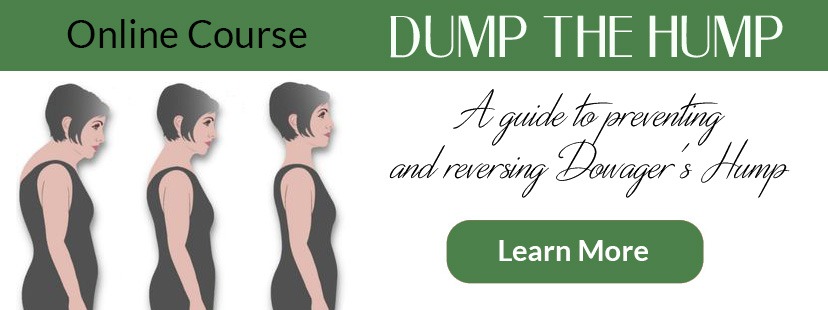Many of my clients, friends, and even strangers ask me this question: can we prevent or reverse Dowager’s Hump? The good news is YES! Honestly, there are several key things you can do to help prevent and reverse this condition. In my class, Dump the Hump: Reversing and Preventing Dowager’s Hump, we show you just how to do this.
In the class we cover much more information than I can in this post, however, in this space I want to drill into one of the most important elements for both preventing and reversing it that does not involve pharmaceuticals, invasive therapies, or surgery. Each of those protocols has its place, but going the natural route, helping your body heal itself with the right kind of help, is always my first, second, and third line of defense.
From more than seventy-seven studies done from 1955-2016 and ongoing, from the experts I include in my class, plus my personal experience, the consensus is that the proper type of regular exercise allows us to stand taller, be more vibrant, and slow down our aging by developing a strong spine. As Roger Sperry, the 1981 Nobel Prize recipient in Physiology and Medicine said, “Ninety percent of the stimulation and nutrition to the brain is generated by the movement of the spine.” When the spine is impaired by issues relating to hyperkyphosis, our cognitive function suffers and we experience cognitive problems and decline.
While watching the news coverage on the life of the late Queen Elizabeth, I noted that she displayed the beginnings of Dowager’s Hump, which became more severe when she stopped exercising regularly. As a life-long horsewoman, a sport that takes strong spinal and abdominal muscles, she did not have the problem the majority of her life. But, it can develop quickly once we lose those strong erector muscles.
The best exercises are those that strengthen the spine, the lower body that supports the spine, and our trunk muscles. As adults, we spend much of our time in forward-folding tasks. Today’s massive use of electronics has lowered the age of people suffering from Dowager’s Hump to the late teens. I now see young teenagers to folks at mid-life, with forward thrusting necks and curving upper spines from constantly being on their phones or hunched over their computers. We can stop and even reverse this trend with proper exercises.
Until next time… Be Vibrant!
Related articles:
Do I Have Dowager’s Hump? How Would I Know?
Reversing the Dreaded Dowager’s Hump
